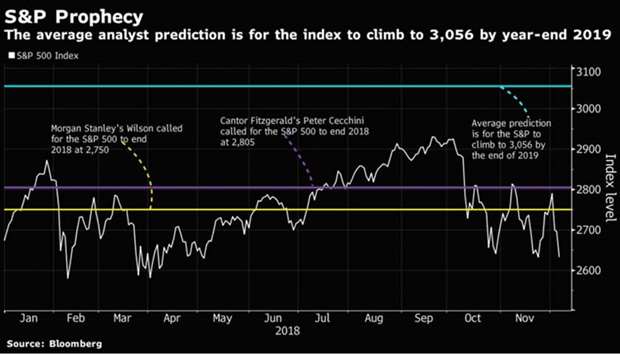With just three weeks to go, 2018’s market contrarians are proving prescient. The outlook was decidedly bullish for US stocks and developing-nation assets 12 months ago, with both forecast to build upon a stellar 2017. The beaten-down greenback wasn’t expected to fare any better in 2018, as a rosy international growth outlook threatened to lure investors away from American markets. And despite some tough talk between the US and China, risks of an all-out trade war were an afterthought.
Not much has gone according to plan, but DWS, Cantor Fitzgerald and Morgan Stanley were among the few who bet against the trend and got it right. Federal Reserve rate hikes against a backdrop of sharply escalating trade tensions roiled markets in 2018, punishing US stocks and causing risk-averse investors to flee developing nations. Meanwhile, the down-and-out dollar has gained against virtually all major currencies amid rising rates and buoyant US growth.
Here’s what those who called 2018 correctly expect in the New Year:
Stalling dollar: Stefanie Holtze-Jen, chief currency strategist at asset manager DWS, is among the vindicated.
In February, after the dollar’s worst annual slide in 14 years, she called for the greenback to strengthen to $1.15 per euro by March 2019, from the prevailing level of about $1.23. The argument that the US’s twin deficits would depress the dollar was over-hyped, according to Holtze-Jen, who saw extreme bearish positioning setting up a rebound.
The dollar’s rally starting in mid-April proved her right – inflicting pain on global investors. But Holtze-Jen doesn’t expect another strong year for the greenback. She sees the euro ending next year at $1.15 as slowing growth and European political woes weigh on the common currency, while the Fed approaches the end of its hiking cycle. Expectations for Fed rate increases have crumbled, with markets now pricing in less than a quarter-point of tightening in 2019. Most forecasters expect the euro-dollar pair to reach $1.20 by the end of 2019, according to a Bloomberg survey, from about $1.14 now.
“The Fed has come back from autopilot,” said Holtze-Jen. “Their calls will be more data-dependent. That’s something that takes the needle lower on the dollar going forward.”
US equities gloom: When it comes to US stocks, 2018’s bears are still skeptical. For months, Cantor Fitzgerald’s Peter Cecchini has forecast the S&P 500 to finish the year at 2,805, one of the more bearish projections among Wall Street’s strategists, and almost 7% above Friday’s close.
A deceleration in US growth, driven in part by higher funding costs on tighter financial conditions, and a frothy commercial and industrial loan market will create credit stress next year, according to Cecchini.
“Our disposition towards equities has moved from buy-the- dip to sell-the-rally,” said Cecchini, Cantor’s chief global market strategist. “If I’m not constructive on the credit markets, then I won’t be constructive on the equity markets.” He has company in his pessimism. Morgan Stanley’s Mike Wilson, the biggest equity bear on Wall Street, forecast last month that the S&P 500 will end 2019 at 2,750, the same target he called for this year. As the fiscal boost from tax cuts wears off and global growth decelerates, Wilson expects a “material” deceleration in corporate profits.
That’s at odds with what most strategists expect. The average prediction as of the end of November was for the S&P 500 to climb to 3,056 by the end of next year, according to 14 forecasts gathered by Bloomberg. It’s the most optimistic year-ahead call since 2009.
Emerging cheer: Jordi Visser at Weiss Multi-Strategy Advisers, who predicted the peak of the developing-market rally in late January, expects emerging markets to be a bright spot in 2019 as the dollar stumbles. Visser is calling for the iShares MSCI Emerging Markets ETF to outperform the S&P 500 Index by 15% to 20% in 2019. Chinese Internet stocks, developing-nation sovereign debt and emerging-market currencies look particularly attractive.
“Bullishness comes from an expectation of a weaker dollar next year on the back of easier US monetary policy, the lag of recent Chinese stimulus measures and a focus of value as a factor in 2019 rather than growth,” said New-York based Visser, chief investment officer at the $1.7bn hedge fund.
Tania Escobedo, a strategist at RBC Capital Markets LLC who correctly called a slide in the Brazilian real this year when most of the market was bullish, now has another contrarian call for 2019. She’s wagering against the real and going along the Mexican peso.

Graph 2
